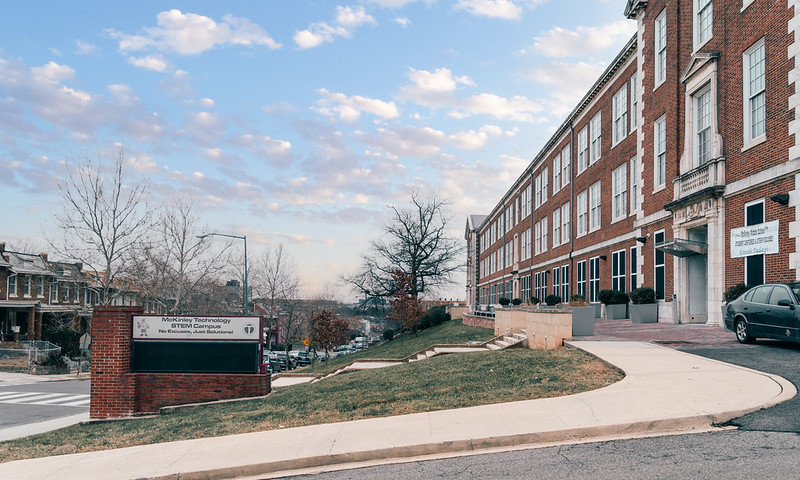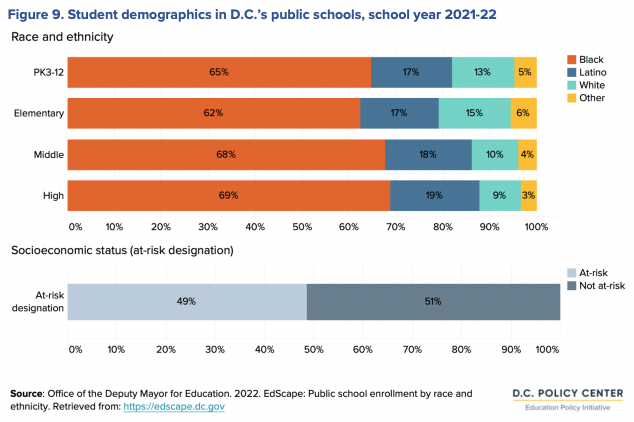DC’s school boundary review could advance equity, advocates say

McKinley Technology STEM Campus and its surrounding neighborhood by Ted Eytan licensed under Creative Commons.
This year, DC will review the school boundaries that determine where students get a guaranteed seat, and make recommendations on whether assignment policies should change based on a variety of equity measures.
The District will look at factors such as overcrowding, the number of spaces for at-risk students and out-of-boundary students at highly sought-after schools, access to specialized programming, and whether students can get to their desired school safely and affordably. This year’s assessment is the first in a decade and only the second since 1968; they’re now slated to happen every ten years.
The previous review process in 2014 was a complicated one, as it had to contend with dramatic changes to public education following the closure of over one in 10 DC public schools — mostly in low-income neighborhoods — and the large-scale introduction of charter schools. Experts say the mass closures of under-enrolled schools disrupted feeder patterns (the path a student takes from elementary to high school) and provoked anxiety about uncertain school assignments.
With this work in the rearview mirror, advocates hope equity has a chance to take a front seat.
“We can absolutely center equity as the priority and look at the ways where when we have a vision of our public school system in the city where every child is getting absolutely what they need [and] has the range of opportunities that we know every child deserves,” said Abigail Smith, the former DC Deputy Mayor for Education, at DC Policy Center’s recent launch of its report on school boundaries. “We can use student assignment policies to help us get there.”
The DC Policy Center report offers insight into advancing equity in the review process, as well as ways to use school boundaries to increase diversity, access to in-demand schools, and to relieve overcrowding. However, exactly what equity means and how to achieve it are complicated questions in a city with a high degree of choice: less than half of DC’s schools even have a guaranteed spot for students who live in a particular area.
Most researchers and advocates agree that boundaries can only be one part of the solution to better serving DC’s students.
“We have to think about equity in a really multifaceted way because student assignment is not going to be the only thing to get us there,” said Faith Gibson Hubbard, the Chief Strategy Officer at PAVE, a DC education advocacy nonprofit.
Boundaries today reflect, perpetuate historic harms
The DC Policy Center’s report finds that just 28% of public school students attend the institution where their address guarantees them access. The rest — 72% — use the common lottery, through which they can apply to charter or traditional public schools across the city.
But boundary participation isn’t spread equally across the District, suggesting that many families feel like their neighborhood school can’t offer an education on par with the rest of the city. A student’s likelihood of doing so depends on where they live and how old they are — elementary school students, for example, are most likely to attend their assigned school, while high school students are least likely to.
When it comes to boundary participation, one feeder pattern stands out. Jackson-Reed, made up of some of the wealthiest and whitest neighborhoods in the city’s upper northwest corner, has boundary participation of 79%, almost three times higher than the District’s average. It also has the highest level of private school enrollment. Almost half of the students in Ward 3, which roughly overlaps with the Jackson-Reed feeder pattern, attend private school, while the citywide average is about 16%.
“Within the Jackson-Reed feeder pattern, families tend to have the resources to either choose where they live and therefore choose their by-right school or choose to attend a private school,” said Chelsea Coffin, the Director of the Education Policy Initiative at DC Policy Institute and one of the report’s authors.
While all families with kids in DC have access to choices through the lottery system, Coffin adds, they don’t have the same degree of control. At Anacostia, Ballou, Dunbar, and Woodson schools — all located in the south and east of the city — less than 20% of students attend their by-right school.
Boundary participation rate by grade band and feeder pattern, school year 2021-22. Source: DC Policy Center, used with permission 
Education inequality maps onto the ways that other resources are unfairly divided in DC, quite literally. The city’s school boundaries reflect the historic redlining maps used to decide who could get mortgages based on their race in the 1930s. In 2019, an Urban Institute report found that across the country, these lines create divisions not only based on race but also on other factors like student-teacher ratios, funding, and test scores.
DC is among the country’s most segregated cities and has dramatic income inequality, which tends to be divided along racial and geographic lines. White residents, congregated predominantly in the city’s northwest, have a median income of $141,650 — three times higher than that of Black residents, who are more concentrated in the southeast.
Adjusting school boundaries can have an impact on some of DC’s inequities, according to the DC Policy Center’s report, and can rebalance students to address both under-enrollment and overcrowding. Elementary schools in Southeast DC in particular are overcrowded in spite of having low boundary participation. But Coffin says that the impact from tweaking these boundaries is limited in scope, given the larger issues with resource distribution across the city.
“When you move boundaries, you are changing the distribution of students, but you’re not expanding the pie or making it sweeter,” said Coffin.
New boundaries and beyond
For a strategy with more potential, Coffin points to equitable access preference, a policy piloted for the first time in 2022 at 24 public charter and DCPS schools which gave lottery priority to at-risk students: those experiencing homelessness, in foster care, receiving government benefits, or who are overage in high school. Currently, at-risk kids are less likely to use the lottery. When they do, they’re less likely to get into their desired school. Lottery preference could give them a more equitable shot at getting into their desired school and also boost school diversity.
Coffin adds that allocating more resources to by-right schools could also be a part of this conversation. Gibson Hubbard agrees that school boundaries are only part of the equation, and added that they don’t solve for programming or curriculum.
“I want to be more hopeful about student assignment creating equity but I don’t know if literally assigning students certain places or drawing a line will do that. It’s one tool towards that but there are always going to be people who make a choice,” said Gibson Hubbard. “We have a large income divide in the city and some people can easily make that choice and other people can’t.”
Student demographics in DC’s public schools, school year 2021-22. Source: DC Policy Center, used with permission. 
Beyond rethinking boundaries, this year’s review process is an opportunity to think about education holistically and to hear from communities what that means for them. Gibson Hubbard, who was a community representative and studied the boundary review process for her dissertation, said this is a lesson from the 2014 review, which strove for widespread community input. Smith describes holding hundreds of focus groups with community members. This year’s review process will also prioritize engagement from parents, nonprofits, students, and residents through interviews, focus groups, and surveys.
Gibson Hubbard points to early action pre-Kindergarten, which guarantees a child a spot at their in-boundary school, if it’s among the participating schools, as something that came from community input in 2014. (DC’s free early education used to be only by lottery). She adds that specialized programming, such as Montessori programs, better mental health services, and language immersion are all things that can help schools better serve their students — and could be on the table for this year’s review.
Improving students’ ability to get to school safely is another major equity concern, as students in wards 7 and 8 in particular face longer commutes, higher levels of community violence, and fewer sidewalks and crosswalks.
It’s why Smith encourages a central tenet for guiding the process: “Embrace the principle of centering our most impacted and traditionally marginalized communities as we engage in this process.”
